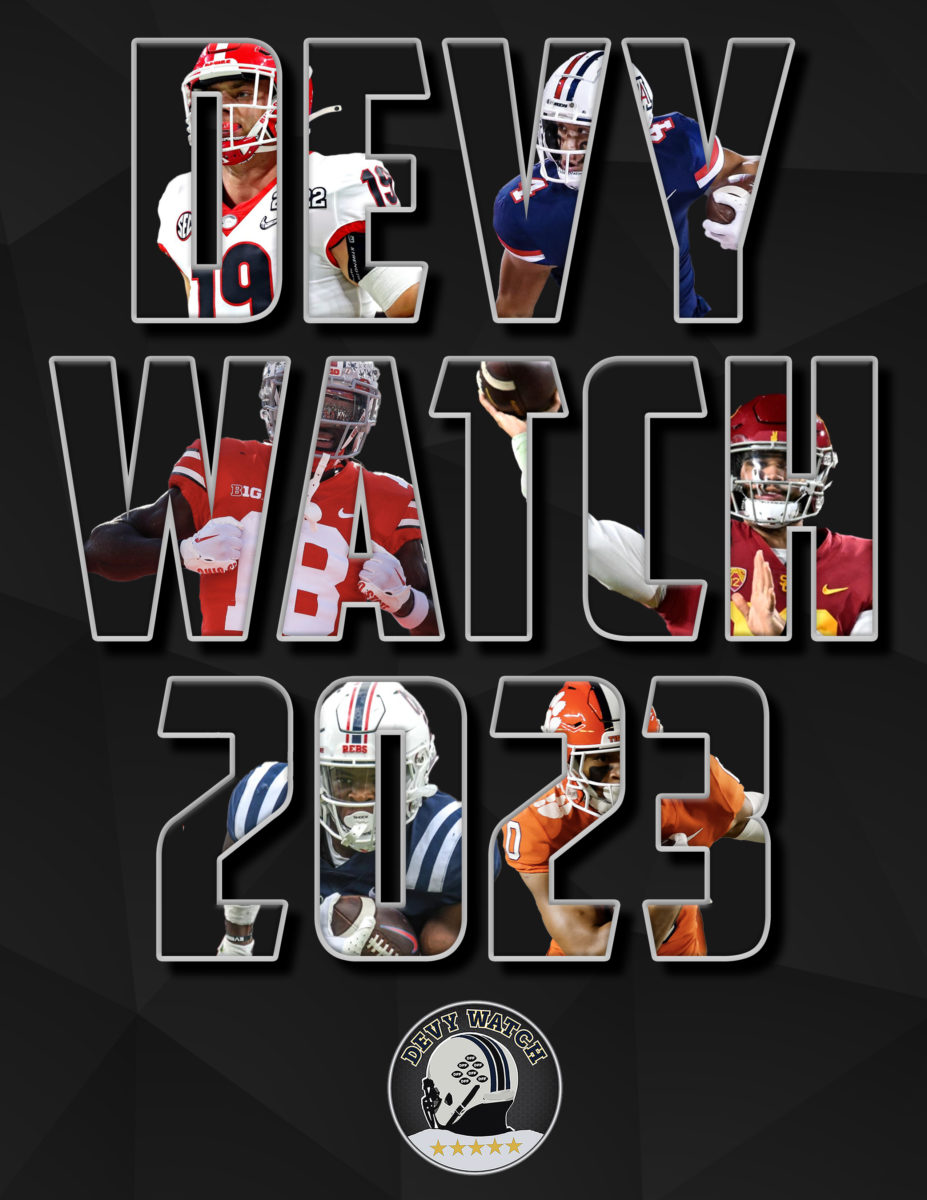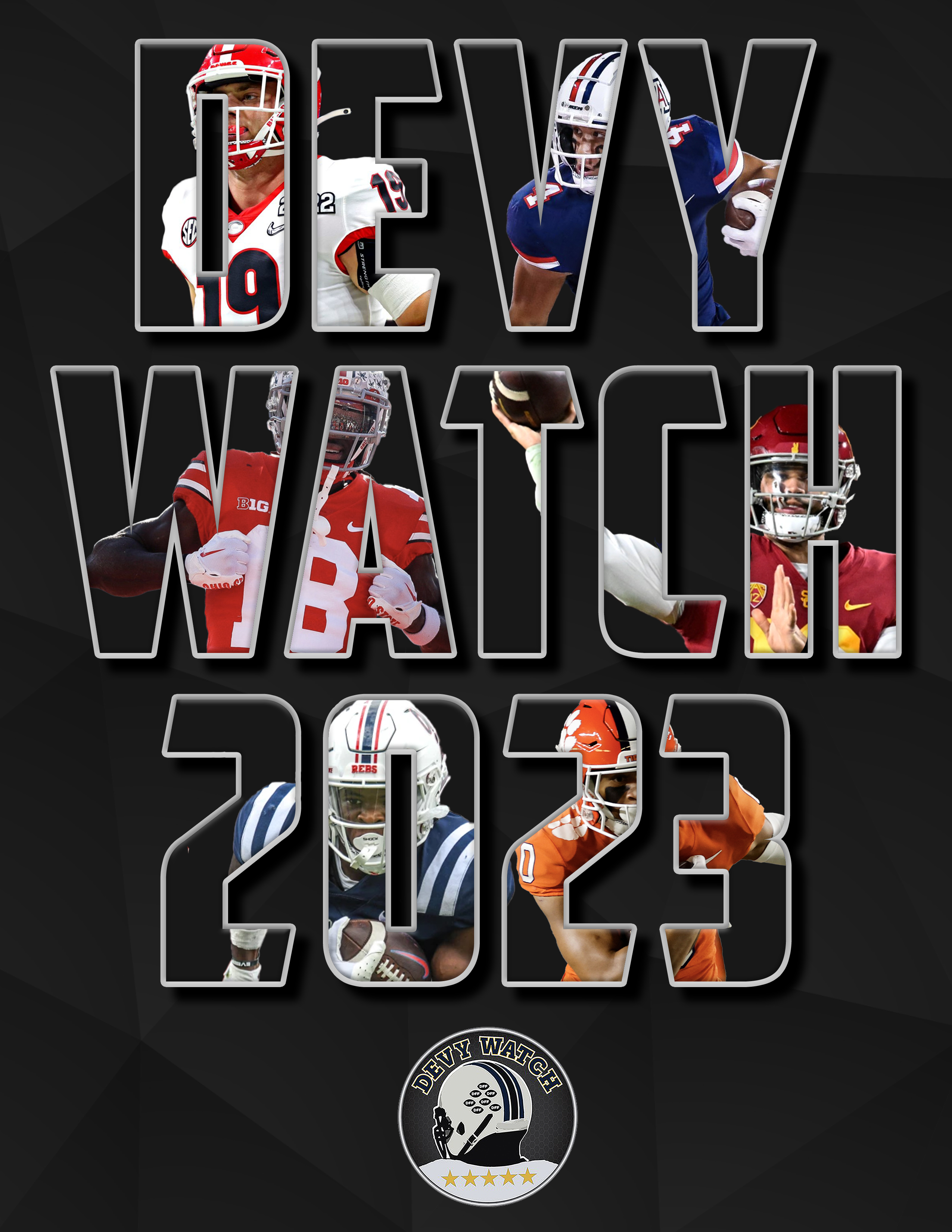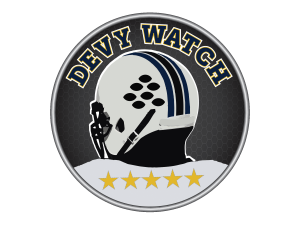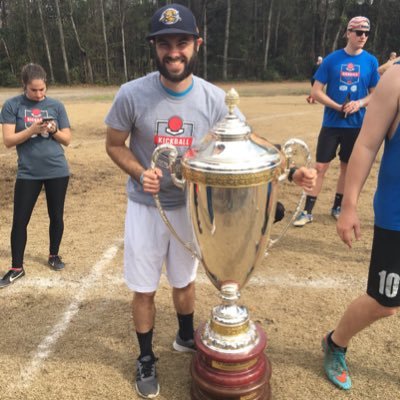With the release of my CFF rankings on 7/26/19, I wanted to take some time to give further insight into my process and further illuminate why I elected to place a guy where I did and how I view my structuring of tiers. I’ll continue to release my conference previews over the next two weeks where I’ll continue to talk in detail about each team and their relevant players.
Quarterback
I broke down QBs into three main tiers that I want to talk about. Assuming most of us play in 2QB leagues, I ideally want to leave a draft with a tier 1 player. For me, that’s only seven guys. If there is an early QB run and you elect to stack some wide receivers early on, then I would recommend taking two tier 2 QBs and possibly a third. I’ve only tried that approach once this year, but I was pleased with how it turned out. In a P5-only industry best-ball draft, I took Spencer Sanders, James Blackman, and JT Daniels at varying price points. In tier 1, the main feedback I’ve gotten is the surprise of having Hawaii’s Cole McDonald at QB3. I do not share the concern of some that he may be replaced by Cordeiro. McDonald was elite before suffering an injury that caused internal bleeding and the engorging of his testes. We’ve recently found out that he strained his MCL in week one as well, so he was pretty much injured for the entire season. Assuming good health, he could finish as the overall QB1 and has a top 10 floor. Some will feel antsy that Justin Fields hasn’t been named the starter at Ohio State. I’m not one of them. I could argue that he’s the most talented QB in college football. The most jarring omission I made was of Ohio QB Nathan Rourke. I don’t believe he will be able to repeat his absurdly high touchdown rate this season after losing his best WR and the majority of an elite offensive line. I’ll pass on him at his ADP of QB5 on Fantrax.
Tier 2 features 19 players. 15 of the 19 are entrenched starters while Spencer Sanders, Gage Gubrud, Jamie Newman, and Brandon Wimbush have some meat left on the bone. I feel confident enough about each of them to include them in this group. The big surprises of this group are probably Woody Barrett, Tommy Devito, Malcolm Perry, James Blackman, and Holton Ahlers. The first four guys being ranked higher than the consensus and Ahlers being ranked lower. The first four are players whose talent I believe in as well as they play in schemes that have produced top 10 QBs in multiple seasons. All four are generally cheap enough where you could conceivably roster all four and not pay a king’s ransom. To further illustrate that, their late July ADP on Fantrax is QB53, QB 34, QB20, and QB142. Ahlers is a player that I targeted a bunch last summer in dynasty drafts. I normally don’t prioritize drafting true freshman, but I knew this kid had it and he played as a dual-threat in an air-raid. However, the coaching change hurts. He likely still eclipses the 100 carry mark, but they aren’t going to be throwing it 35+ times per game anymore. The pace will slow considerably and they will want to get the RBs more involved. He’s going to need to cash in on a lot of rushing TDs this season to live up to his ADP of QB9. I’m not actively looking to sell in dynasty leagues but I also haven’t drafted him in any startups this summer.
Tier 3 consists of players who I think are great backups and spot starters with the right matchups. I don’t necessarily want to be reliant on guys from this group every week but they are the best of the rest. Many of these players are available very late in drafts, and I believe better options than drafting an RB or WR in a marginal scheme. The most controversial players in this group are Texas A&M QB Kellen Mond and Utah State QB Jordan Love. They seem to be quite popular in rankings and drafts alike. Fantrax has Mond’s ADP as QB14 and Love’s as QB11. That’s a pass for me. Jimbo’s scheme isn’t typically a breeding ground for weekly starters and while Love possesses NFL talent, he will be playing behind a rebuilt offensive line, in a new scheme, and will be without his best playmakers from last season. I would much rather take Dorian Thompson-Robinson as QB112.
I’ll touch on a few miscellaneous items as well. Oregon QB Justin Herbert is my QB51 at the head of tier 4, but he’s being drafted as QB18. Sure, he’s a first-round NFL pick, but the scheme he plays in is very uninspiring. Each season, NFL guys get drafted too early based on their name recognition. Unfortunately, he is not even the most glaring example that I’ve seen this year. Jake Fromm is my QB74 but he’s being drafted as QB21. No further comment is necessary. I’ll say this, I would rather draft Fromm as QB21 than McKenzie Milton (Out for year) as QB29! I elected not to include the Illinois, Auburn, TCU, Boise State, Arkansas, or Miami QBs in my ranks. There is a historical precedent that supports each school having a relevant QB. However, the position may take a few weeks to sort out, thus depressing their values and the races are close enough that I preferred not to rank them. That being said, I would rather take a shot on landing both guys in each scheme than drafting some players that I have in tier 5 and beyond.
Running Back
I attempted to be orderly with my first two tiers. I went with twelve players in each tier. Ideally, I end up with at least two or more guys from that group on most of my rosters. The good news is that running back values are all over the map from various CFF analysts and the Fantrax ADP is a manifestation of that. Starting with my first tier, it appears that Auburn’s JaTarvious Whitlow (RB54 on Fantrax) is my most controversial inclusion. I detailed my thoughts in my SEC preview, but I’ll reiterate that he will play behind an excellent offensive line, has the pass-catching ability, and benefits from Malzahn taking over as a play-caller. There are multiple instances of Gus’ RB1 getting 300+ carries in a season and 1,000+ yards is a foregone conclusion. Many owners may be scared of his schedule. I don’t love it, but Gus’ backs in the past didn’t have a lot of favors done for them in that department either and they still were excellent. My glaring omission was Clemson’s Travis Etienne. He touched the ball 216 times in 15 games last season. He scored 26 touchdowns. I acknowledge that he is an elite runner and his touches likely increase slightly, but I don’t prefer to bet on outliers and that is what I think he would need to be to pay off his RB3 ADP.
My second tier is a real smorgasbord of guys relative to other analyst’s rankings and Fantax’s ADP. My inclusion of Clyde Edwards-Helaire as RB23 seems to be in stark contrast with his Fantrax ADP of RB92. He’s currently being the second back selected on his team behind talented true freshman John Emery. I’ve been pretty vocal all off-season about my backing of CEH. If you blend the two guys responsible for orchestrating their offense in 2019, you get a track record of 250+ touches and also using a back like Alvin Kamara. I’m buying his potential this season and it can be done at a steep discount right now. Isaiah Bowser is in line for 275 touches in 2019, but he’s being valued much lower than I believe is appropriate (RB48). My biggest omission in terms of the consensus and my ranks is Chuba Hubbard. I’m a huge fan of his talent, but the new offensive coordinator hasn’t given his backs the requisite volume over the past two seasons that support taking him as RB13. Mike Gundy commented at media days that the offense won’t change much, so it’s possible that I’ll be way off on him with my RB40 ranking of him. I’m fine if I miss him. Najee Harris is being drafted as RB23 but I don’t want any piece of him at that price. There is a Bama tax here, and I won’t pay it. Jafar Armstrong is my biggest riser as I’ve looked more at the big picture late this summer. He also has WR/RB eligibility on Fantrax which makes him incredibly valuable. Tier 2 presents a ton of value in my ranks when comparing it against Fantrax’s ADP. This is a great tier to spend time in if you are stockpiling WRs and top QBs in the early rounds.
My third tier spans forty players and they represent a nice blend of backs that are stepping into potentially massive roles in 2019 as well as guys who have their work cut out for them to win the job. Boise has a 1,000-yard rusher every year. As such, it makes sense to rank their man as a top 25 asset. The problem is that the word out of camp has vacillated. Early on, it seemed very likely that Andrew Van Buren would be the RB1. Since then, the staff indicated that Robert Mahone was in the lead. As such, I’ve elected to take a more conservative approach on my ranking of Andrew Van Buren. Earlier in the summer, I was able to draft both AVB and Mahone late in drafts. Since then, the market has firmed on them and that’s harder to execute. It’s harder to land Van Buren, I should say, Mahone is still available at the end of many drafts. While I believe that AVB should win the job, I’ve taken Mahone late in drafts and shooting for the mega millions payout. Ranking AVB here doesn’t fully jive with my internal thoughts on the matter, but I think avoiding him at RB25 is the approach I feel most comfortable with at this juncture. I’ll say this, if I took AVB at that price I would go ahead and bite the bullet and overpay for Mahone. Securing the backfield is of paramount importance to me if I go that direction. I’m concerned that Deandre Torrey won’t get the volume he needs to be a tier 2 back with the new scheme, so I’ve taken a cautious approach with the North Texas back. Another duo I have ranked in this tier are Trey Ragas and Elijah Mitchell. I had a hard time ranking them as RB44 and RB45. However, I had a hard time ranking them any higher. They will run behind an elite OL this season and if I were to make either back a part of my 2019 plan then I would be sure to select both guys back-to-back. Fantrax has Mitchell’s ADP as RB27 while Ragas is RB64. If that plays out in your draft and Mitchell goes that early, be sure to snag Ragas at that price. If you’re taking Mitchell as RB27 then take Ragas as RB28. Perhaps my most controversial ranking of all is Cincinnati’s RB Mike Warren as RB41. This staff rarely uses a bellcow approach and there are three very talented backs behind Warren that could eat into his workload. I prefer a strategy of fading him early in drafts (RB6 on Fantrax ADP) and taking his running mate, Gerrid Doaks at the end of your draft. If not for Doaks’ injury last summer, we may not know too much about Warren. There are tons of guys in this range that I think are screaming values. I believe that filling out a roster with many of these backs will help owners to win many leagues this season.
I have a few other thoughts about the backs in tier 4 and beyond. Some potential surprising inclusions may include Ronnie Rivers, Marcel Murray, Stevie Scott, Reggie Corbin, Ricky Slade, Jordan Cronkrite, and Anthony McFarland. All of these guys either likely fall victim to a less voluminous scheme change or they get talented guys back that are likely to take away from their market shares. At the same time, I could see backs like Wesley Kennedy, Ty Chandler, Juma Otoviano, Dedrick Mills, Tra Barnett, PK Kier, Alex Fontenot, Shaq Vann, Jonathan Ward, Isaih Pacheco, Connor Heyward, Vavae Malepeai, James Gilbert, and Michael Carter (among others) could all far exceed my ranking of them. All of them currently have some unanswered question, but I believe they are great targets late in drafts. There were even more guys than what I listed that I believe could have productive, fantasy viable seasons.
Wide Receiver
I’m not entirely satisfied with how the tiers shook out for this position. I elected to go with 24 guys in tier 1. Ideally, when I think about tiers, it means each guy is interchangeable and in this particular instance that’s not an accurate representation of my beliefs. However, this is the group that I recommend rostering as many as possible. These are all proven players that play in favorable systems. Perhaps I would have been better served to make tier-one just two players: Rondale Moore and Tylan Wallace. In reality, those are the only two I’m considering with my first pick at WR. I could have probably drawn another tier break after James Proche at 15 and then finished a third after 24. I didn’t, so here we are. I have several controversial rankings here that I’ve already heard about from many. Let’s start with Laviska Shenualt. I love him. I think he will be an elite NFL WR, and I’ve been on his train since this time last summer before he had done anything significant at the collegiate level. If you think I’m gonna stop quote tweeting SHENAULT clips, think again! That being said, I think it is ill-advised to just assume he will replicate his 2018 season. The reason is two-fold: the potential for a nagging toe injury that has reportedly been somewhat of an issue this off-season and more importantly, the new offensive coordinator. His head coach is a career defensive assistant. His roots are in the NFL, under Nick Saban, and Kirby Smart. That doesn’t scream fun, innovative, pass-first offense. To make matters worse, his OC hire was an offensive analyst as Georgia for the past two seasons. Let’s do an exercise. Let’s just assume that Colorado runs Georgia’s offense from the past two seasons but instead of Jake Fromm at QB, you have Steven Montez. How high are you drafting Shenault? It’s imperative that this scenario is seriously considered. Would they be wise to get conservative and not feed him the ball 10+ times per game? Absolutely not. However, it’s not a great process (in my opinion) to assume that’s the case. Jay Johnson has been an OC for six seasons in college. He’s had a 1,000-yard receiver just once. He never had a QB throw more than 34 times per game and had one that threw for as few as 25. For perspective, Colorado threw it 35 per game last year and Georgia threw it 26. His WR1 averaged 57-820-5 over six seasons. Will he be getting goal line carries again? I’m willing to give a talent like Shenault the benefit of the doubt, but I’m strongly advising allowing your league mates select him as WR3 and instead take your shots on guys like Tamorrion Terry, Lynn Bowden, and Isaiah Hodgins who are being drafted as WR32, WR67, and WR72. Let’s bump Shenault up an extra 25% on Johnson’s average WR1 ~ 70-1025-6. Very serviceable, but disappointing if I take him as my team’s WR1. As much as anything, I want my rankings to reflect who to avoid at their high ADPs and which guys I believe to present values. So if Shenault being listed as WR17 triggers you too much, just remember this: proceed with caution when forecasting his 2019 season.
Aside from undervalued guys like Lynn Bowden, Isaiah Hodgins, and Kerith Corbin, I’ve been heavily targeting some guys at the top of my second tier. Eric Kumah, Dazz Newsome, Corey Sutton, Obi Obialo, and Sage Surratt have been near the top of my queue in many drafts this summer. All of these guys have tremendous abilities and also step into a situation where 70 grabs and 1,000 yards are readily available in 2019. Their ADP on Fantrax is WR60, WR78+, WR35, WR78+, and WR56. Needless to say, if any of them do have 70-1000 this year then they will be immensely valuable at their current price tags. I included both Tee Higgins and Justyn Ross as my WR39 and WR40. I went back and forth on those. I probably priced them closer to their floors, but I’m not clear which guy may be the leading target man and whether or not anyone else will carve out a role this year. I don’t have either player on any of my teams, but I think at least one, if not both, outperform my conservative rankings. However, their current ADP of WR10 and WR11 is too rich for me, so this is another scenario where my main advice would be to avoid them at their premium prices. Normally, I like cornering an uber-productive position group, like Clemson’s WRs, but they just cost too much for my budget. I included the Syracuse outside WRs in this group and their cost is such that I would recommend nabbing both Trishton Jackson and Taj Harris at their ADPs of WR66 and WR78+. Sean Riley plays inside WR and is being drafted as WR45 on Fantrax. That hasn’t been my experience in drafts, I’ve seen him go much later than that, particularly in dynasty formats but I also like the strategy of grabbing both him and Nykeim Johnson, who is always available very late in drafts. The last duo that I’ll touch on in this tier is North Texas’ Rico Bussey and Jaelon Darden. Bussey, coming off a 1,000-yard 2018, is being drafted as WR14 on Fantrax. However, they hired a new offensive coordinator and while it will remain an air-raid, history shows it can operate best through their slot receiver. For those of you old enough to remember the ole’ man, Cooper Kupp was a menace playing slot WR in this scheme. Over four years his receiving line was 428-6464-73. That’s 107-1616-15 per year. I’m not saying that Darden is as talented as Kupp, nor am I operating with a deep conviction that he will be an elite producer this year, but I’m very willing to pass on Bussey at his early ADP and select Darden as WR78+. I’ll write more on this later, but Darden is one of my favorite bargain bin WRs this season. Unfortunately, I got on this train of thought too late this summer to draft him in more leagues than I have. He’s likely rostered in many leagues due to him being a viable flex player last year, see if you can offer his owner a flex player off your roster in a trade and nab him. Lastly, I included Iowa State’s Tarique Milton as WR50. I believe that he could step up for the ‘Clones in 2019 and be the next 1,000-yard receiver that we’ve come to expect in recent years. If he is, he will outperform my ranking for him, which is considerably higher than I’ve seen him ranked elsewhere.
My third tier spans 50 receivers. There are so many guys that I want to have on my team in this group. The biggest reason they are ranked the way they are is that I just don’t have enough confidence in how position battles will shake out. In some instances, I made an educated guess on who will fill a valuable role in a historically productive offense. Boise State’s John Hightower and Khalil Shakir, Indiana’s Donovan Hale, Hawaii’s Melquise Stovall and Jojo Ward, Pittsburgh’s Maurice Ffrench, WKU’s Lucky Jackson, Washington State’s Easop Winston and Calvin Jackson, Southern Cal’s Tyler Vaughns and Michael Pittman, Arkansas’ Mike Woods and Trey Knox, Maryland’s Jeshaun Jones, Kent State’s Isaiah McKoy and Mike Carrigan, La Tech’s Isaiah Graham, FSU’s DJ Matthews and Keyshawn Helton, Baylor’s Josh Fleeks, Colorado State’s Nate Craig-Myers, Toledo’s Bryce Mitchell and Desmond Phillips, and Nebraska’s Wan’Dale Robinson are all players that could finish considerably higher than where I have them ranked. I would even go as far as to say, if you have conviction about any of them, the historical precedent combined with their current costs make them exactly the types of guys to aggressively target. The only player I would directly caution against that I included is Hawaii’s Jojo Ward. His ADP of WR26 is in direct conflict with the historical averages of Hawaii’s outside receivers. Getting good info on Hawaii football is tougher than looting gold bars from Ft. Knox, so perhaps he slides inside this year and he bails out his owners. I’m not betting on that being the case. This tier and the next largely represent players with vast potential ranges of outcomes. There were a bunch of wide receivers that I chose to omit from my overall rankings because I didn’t feel I could make an educated guess about who would take the mantle. Those include, but aren’t limited to Fresno State, ULM, Duke, Cincinnati, Georgia Tech, New Mexico. Some historical seasons within their schemes lead me to believe they can all produce fantasy-relevant receivers. There are other teams and schemes like App State and NC State that will likely host two relevant receivers, but they were also position battles that I elected not to guess on. That being said, there will reach a point in every draft where taking shots on some of the recently mentioned position groups where it makes sense to try and hit the jackpot with a late pick.
Tight End
I’ll be brief for the first time. I split this group into three tiers. Similar to the tier-methodology that I used with quarterbacks, my first tier are the guys that I’m willing to use a middle-round pick on, as opposed to waiting until late in drafts. The first tier consists of players that I think have the potential to catch 50+ balls. They all play in schemes where there is excellent historical production, and they are either already proven or I believe them to be elite talents at the position. There aren’t any surprises in there nor glaring omissions, so I haven’t been yelled at yet. In drafts, if I elect to pass on a tier-one TE, I’m sure to take a minimum of two tier 2 guys and I’d like to have a third. In my draft experiences this summer, it’s been fairly easy to end up with three guys in the second tier and it doesn’t cost very much. There is some intrigue with tier 3 guys such as Dalton Keene, Cade Brewer, Mitchell Brinkman, Farrod Green, and Kylen Granson, all due to some impressive seasons in the past from TEs in their offensive coordinator’s scheme. I feel less confident about each of them for a variety of reasons, but love the idea of taking a shot on them as a TE4 in leagues where I start two TEs each week.










